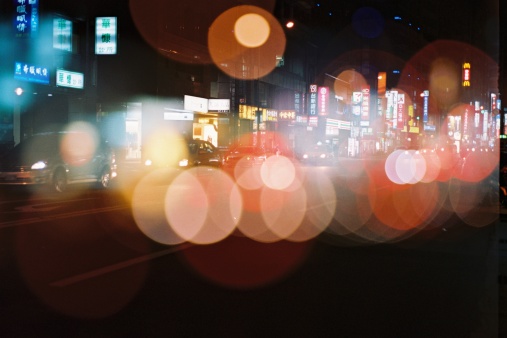Stochastic Origins of EUV Feature Edge Roughness (original) (raw)
Frederick Chen
Looking at tech differently
Published Jul 5, 2021
Due to the higher energy of EUV (13.3-13.7 nm wavelength) compared to ArF (193 nm wavelength) light, images produced by EUV are more susceptible to photon shot noise.
Figure 1. (Left) 40 nm dense (half-pitch) line image projected onto wafer at 35 mJ/cm2; (Right) 20 nm dense (half-pitch) line image projected onto wafer at 70 mJ/cm2. The label numbers indicate photons/pixel (1 nm x 1nm for ArF (left), 0.5 nm x 0.5 nm for EUV (right). Photon numbers are simulated according to Gaussian-weighted random sampling between -3sigma and +3sigma as determined from the local photon dose and the Poisson distribution.
The projected images are generally smoothed by photogenerated species diffusion (such as acids, secondary electrons, etc.), which are often represented as Gaussian blur functions [1]. Dose-dependent blur can possibly be linked to the emergence of defects [2]. The blur function should only be effective over a fraction of the feature width; otherwise the whole feature is washed out. By applying a reasonable pixel averaging function, the actual printed images may be simulated:
Figure 2. A 7 x 7 pixel rolling average is applied to the images of Figure 1. Pixel size is 1 nm x 1 nm (left) and 0.5 nm x 0.5 nm (right).
The EUV image after smoothing still carries more line edge roughness (LER) than the DUV case. This can be more quantitatively presented as an edge position uncertainty.
Figure 3. Individual line scans for the ArF (left) and EUV (right) cases of Figure 2.
Recommended by LinkedIn
In Figure 3, while the ArF line scans show virtually no edge movement, the EUV line scans show a 1-2 nm range of possible positions for each edge. A larger effective range of the blur (or more pixels being averaged) would reduce this range, but also affect the original line image as a whole as the feature width is approached.
2D features show even more obvious edge variability, as shown in Figure 4.
Figure 4. Hexagonally staggered contacts in a 40 nm (x) by 70 nm (y) unit cell. Left: Incident EUV photon images. Right: 5 x 5 pixel (1 nm) rolling average applied.
There are obvious shape variations from contact to contact, as well as corresponding contact area differences, leading to obvious implications for contact resistance. As estimated earlier [3], a 57 x increase in dose (14.3 x wavelength difference, 4x pixel area difference) would be needed for the 20 nm EUV image to have the same stochastic quality as the 40 nm ArF image.
References
More articles by Frederick Chen
- How Secondary Electrons Worsen EUV Stochastics

Oct 5, 2025
How Secondary Electrons Worsen EUV Stochastics
The stochastic behavior in EUV lithography has often been attributed in large part to (absorbed) photon shot noise, but…
- A Perfect Storm for EUV Lithography

Mar 30, 2025
A Perfect Storm for EUV Lithography
As EUV lithography continues to evolve, targeting smaller and smaller pitches, new physical limitations continue to…
- Application-Specific Lithography: Grid-Assisted Multipatterning Scenarios for 10A-14A Nodes

Mar 4, 2025
Application-Specific Lithography: Grid-Assisted Multipatterning Scenarios for 10A-14A Nodes
According to the International Roadmap for Devices and Systems 2022 Edition [1], the 10A and 14A logic nodes are…
A More Appropriate Electron Blur Function Shape for EUV Resist Modeling
In lithography, it is often stated that the best resolution that can be achieved depends on wavelength and numerical…
- Why Large Language Models Can Find Physics Hard
Feb 12, 2025
Why Large Language Models Can Find Physics Hard
In trying to keep up with the times, I have made it a point to maximize my use of AI tools, such as ChatGPT and…
China’s Multipatterning Breakthrough? Quadruple Hole Patterning by Directed Self-Assembly on a Staggered Via Grid
China’s struggle to gain leading-edge competency in semiconductors is due in large part to limited access to advanced…
Resist Loss Model for the EUV Stochastic Defectivity Cliffs
The occurrences of notorious stochastic defects in EUV lithography have resulted in CD or corresponding dose windows…
Can LELE Multipatterning Help Against EUV Stochastics?
Previously, I had indicated how detrimental stochastic effects at pitches below 50 nm should lead to reconsidering the…
- Stochastic Pupil Fill in EUV Lithography

Dec 21, 2024
Stochastic Pupil Fill in EUV Lithography
The stochastic nature of imaging in EUV lithography is most clearly portrayed by the Poisson statistics of the absorbed…
- Multipatterning Reduction with Gridded Cuts and Vias

Oct 26, 2024
Multipatterning Reduction with Gridded Cuts and Vias
Even with the emergence of EUV lithography, multi-patterning has remained a necessity going into the 3nm and 2nm nodes…